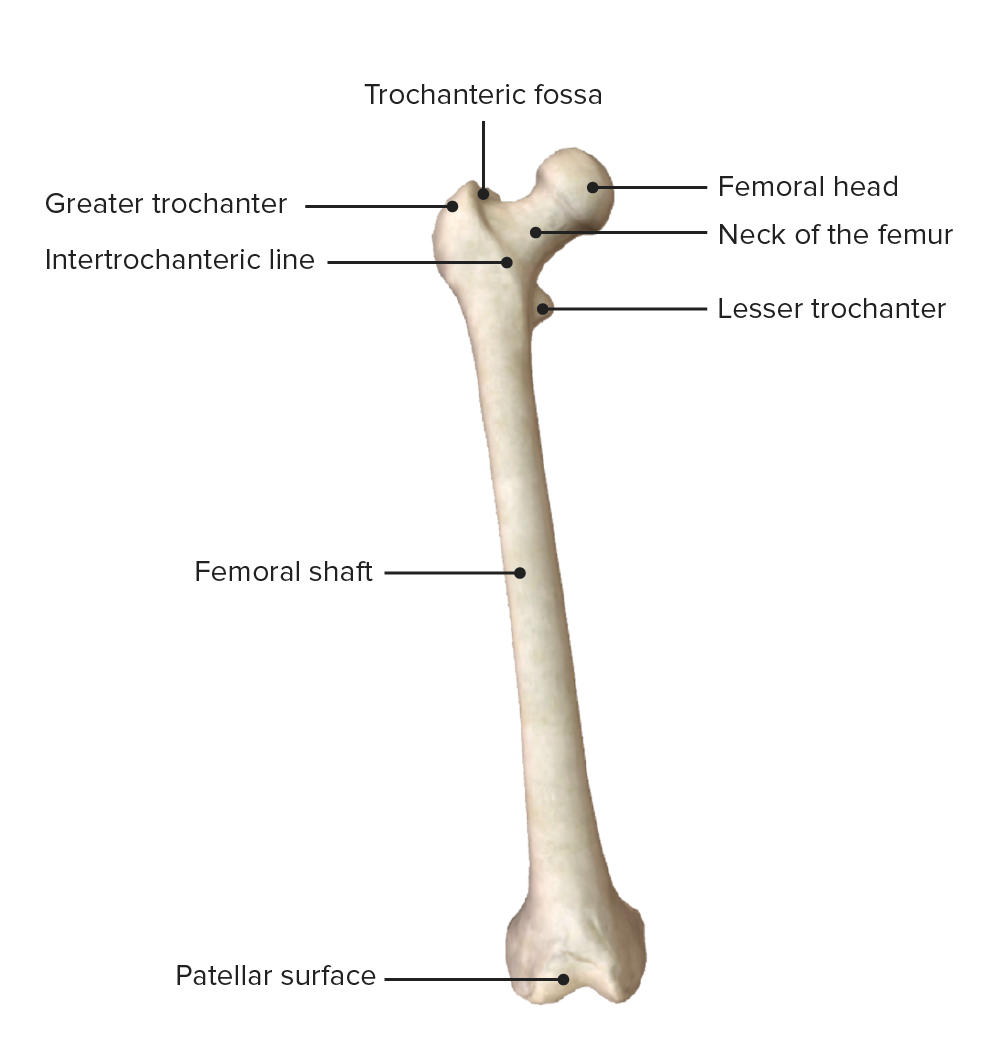Playlist
Show Playlist
Hide Playlist
Arterial Supply of the Thigh
-
Slides Arterial Supply of the Thigh.pdf
-
Reference List Anatomy.pdf
-
Download Lecture Overview
00:01 So now let's have a look at a lot more detail of this arterial supply of the thigh. 00:07 So here we can see we have the anterior aspects of the thigh. 00:11 We can also see some aspects of the pelvis, as we've got the aorta bifurcated. 00:16 Here, we can see the external iliac artery. 00:19 And the external iliac artery courses deep to the inguinal ligament. 00:23 We can see this as it passes through the vascular lacuna, that medial compartment of that sub lingual space. 00:32 The femoral artery then appears within the femoral triangle and we can see the femoral triangle here. 00:37 Remember, the borders of the femoral triangle are the inguinal ligaments, the sartorius muscle and also adductor longus. 00:44 So we can see within the femoral triangle, we have the femoral artery. 00:47 And then we'll immediately position, we have the femoral vein. 00:50 Laterally, we find the femoral nerve. 00:53 But importantly the femoral artery there is sitting within the femoral triangle. 00:58 It then runs down through the adductor canal before piercing through a small hole. 01:03 Remember, the two parts of adductor magnus - the adductor portion and the hamstring portion. 01:09 They created this little hiatus that allowed the femoral artery to pass through at the distal end of the adductor canal. 01:17 As the femoral artery then pass posteriorly, it became the popliteal artery and sits within the popliteal fossa. 01:25 If we then look at the femoral artery, there are a number of branches that come away from it. 01:29 Here we can see we've got the superficial epigastric arteries, these will ascend along the anterior abdominal wall. 01:36 We also have the superficial external pudendal artery help supply some of the skin around the external genitalia. 01:43 And then we have the superficial circumflex iliac artery which is running around to supply structures on the lateral aspect of the hip. 01:52 The femoral artery importantly gives rise to the deep artery of the thigh. 01:56 Sometimes it's called the profunda femoris. 01:59 But this deep artery of the thigh occurs typically at the level of pectineus. 02:04 So looking at the femoral triangle, the floor of the femoral triangle where we have pectineus, you'll see the deep artery of the thigh emerging from this location. 02:13 It then runs deep to quadriceps femoris as the femoral artery then continues down along adductor longus. 02:20 Here we can see the terminal end of the deep artery of the thigh. 02:23 And we'll see this in more detail when we look at the posterior aspect. 02:27 But the deep artery of the thigh really stays within the thigh, it doesn't pass into the leg like the femoral artery does. 02:35 Coming off though the deep artery of the thigh, we see the medial circumflex artery here. 02:41 And we'll also see the lateral circumflex femoral artery here. 02:45 The lateral circumflex femoral lottery actually has two branches. 02:49 It has an ascending branch, which goes up to anastomoses gluteal blood vessels. 02:54 And a descending branch, which will go into anastomoses perforating branches, which we'll see in more detail here. 03:01 But importantly, we've got a circumflex arrangement of arteries that lead from the deep artery of the thigh, which we can see here. 03:08 Medial and lateral, with the lateral giving off some additional branches as well. 03:13 These perforating arteries are important as they go on to supply the posterior aspects of the thigh. 03:19 And they have to really supply the deep structures within the thigh that are surrounding the femur. 03:26 So now let's rotate the skeleton here. 03:28 And what we're doing is we're actually looking into the right hemipelvis, but from the left hand side. 03:34 So what we're looking at is the right internal iliac artery once it's bifurcated off the right common iliac. 03:41 And there we can see the right iliacus. 03:44 So we've removed the left ilium bone so we can see into the pelvis here. 03:49 And this is important because it gives us a nice view of the obturator artery running anteriorly towards the obturator foramen, where it's joined by the obturator nerve. 03:59 Both of these structures pass through via the obturator canal to pass into the adductor compartment. 04:04 We can also add in here some important veins, which have very similar distribution and a very similar name to their accompanying arteries. 04:13 Here now we can remind ourselves of that obturator canal, which allows both the obturator nerve artery and vein to pass from the pelvis into the adductor compartment of the thigh. 04:24 Here we can now see the obturator artery as we look at this right pelvis from the lateral aspect. 04:30 So now we're looking at the external surface of the obturator membrane, and we can see the obturator artery lying on top of it. 04:37 Here we can see it's anterior branch and here we can see a posterior branch. 04:41 Branches are coming away from the obturator artery once it's emerged through the obturator canal onto the external surface. 04:49 If we have a slightly different image to look at that now we can see how the obturator canal is giving rise to the obturator artery. 04:56 And here is both those anterior and posterior branches. 05:00 And these will form an anastomotic loop around that obturator foramen lying on the external surface of the obturator membrane. 05:08 This is important because it allows some redundancy in the blood supply that passes towards the hip joint. 05:14 Now the hip joint is a really important joint and it needs to receive as much blood supply as it can. 05:20 Joints typically are quite difficult to supply with blood because they're highly mobile. 05:25 So we have lots of anastomotic rings that help to supply the hip joint. 05:29 And this is one of them that's helping supply the head of the femur. 05:33 We've got the obturator artery, it's anterior and posterior branches, forming an anastomoses. 05:38 And here we can see the ligament of the head of the femur which is containing that acetabular branch. 05:43 And this runs towards the head of the femur. 05:46 So interestingly here, we've got the femur supplied via the acetabulum from this obturator artery. 05:53 A direct branch into the head of the femur via the ligaments of the head of the femur. 06:00 So now let's have a look continuing at this blood supply to the thigh and overview the muscles that are supplied by this femoral artery. 06:08 So here we see the femoral artery supplying the muscles of this anterior compartment. 06:13 The obturator arteries supply muscles in this medial or adductor compartment. 06:18 And here we can see the deep femoral artery is going to supply muscles in all three compartments with its various branches.
About the Lecture
The lecture Arterial Supply of the Thigh by James Pickering, PhD is from the course Fasciae and Neurovasculature of the Lower Limbs.
Included Quiz Questions
What is the relationship between the femoral artery and vein within the femoral triangle?
- Femoral vein is medial to the femoral artery.
- Femoral vein is lateral to the femoral artery.
- Femoral vein is anterior to the femoral artery.
- Femoral vein is posterior to the femoral artery.
- None of these answers are correct.
What are the branches of the deep artery of the thigh? Select all that apply.
- Medial circumflex artery
- Lateral circumflex artery
- Obturator artery
- Anterior circumflex artery
- Posterior circumflex artery
Which artery is primarily responsible for providing blood supply to the hip joint?
- Obturator
- Femoral
- Inguinal
- Internal iliac
- External iliac
Customer reviews
5,0 of 5 stars
| 5 Stars |
|
5 |
| 4 Stars |
|
0 |
| 3 Stars |
|
0 |
| 2 Stars |
|
0 |
| 1 Star |
|
0 |




